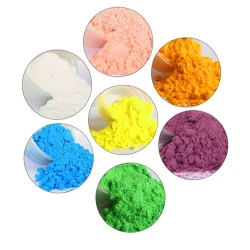Here are some common types of natural pigments and their sources
2023-12-18
Natural pigments are colorants derived from natural sources, such as minerals, plants, animals, and microorganisms. These pigments have been used for thousands of years in art, cosmetics, textiles, and various other applications. Unlike synthetic pigments, which are chemically engineered, natural pigments are obtained directly from nature. Here are some common types of natural pigments and their sources:
1. Mineral Pigments:
- Hematite (Red Iron Oxide): A reddish-brown pigment derived from iron ore.
- Malachite (Green Copper Carbonate): A green pigment obtained from the mineral malachite.
- Azurite (Blue Copper Carbonate): A blue pigment sourced from the mineral azurite.
- Ochre (Yellow and Red Iron Oxides): Earth pigments ranging from yellow to red, widely used in prehistoric art.
2. Plant-Based Pigments:
- Chlorophyll (Green): Found in plants and responsible for their green color.
- Anthocyanins (Red, Purple, Blue): Pigments found in fruits, vegetables, and flowers.
- Curcumin (Yellow): Extracted from turmeric, a yellow spice.
- Betanin (Red): Obtained from beets, providing a red color.
3. Animal-Based Pigments:
- Cochineal (Red): Derived from the dried bodies of the cochineal insect, used as a red dye.
- Tyrian Purple (Purple): Historically obtained from the mucus of certain sea snails.
- Sepia (Brown): Obtained from the ink sac of cuttlefish or squid.
4. Microbial Pigments:
- Monascus Pigments (Red, Purple): Produced by the fungus Monascus, used as a natural food colorant.
- Spirulina (Blue-Green): A type of cyanobacteria that produces a blue-green pigment used in food and cosmetics.
5. Other Natural Sources:
- Lapis Lazuli (Blue): A semi-precious stone ground into a pigment for painting.
- Madder Root (Red): A plant-based pigment obtained from the madder plant.
- Indigo (Blue): Derived from the leaves of the indigo plant.
Applications of Natural Pigments:
1. Art and Painting:
- Natural pigments have been used throughout history by artists for creating paintings, murals, and artworks.
2. Textiles and Dyes:
- Natural pigments are used in the dyeing of fabrics, producing a wide range of colors for textiles.
3. Cosmetics:
- Many natural pigments are used in cosmetics, providing colors for lipsticks, eyeshadows, and other makeup products.
4. Food Coloring:
- Some natural pigments are used as food colorants, adding color to a variety of food products.
5. Traditional Medicine:
- Certain natural pigments, such as those from plants, have been used in traditional medicine for their potential health benefits.
6. Crafts and Hobbies:
- Natural pigments are often used in crafts, DIY projects, and hobbies for coloring various materials.
7. Natural Dyes:
- Natural pigments are employed in the production of natural dyes for fabrics and textiles.
While natural pigments have a long history of use, it's important to note that their availability, color intensity, and stability can vary. Some natural pigments may be sensitive to light, heat, or pH, and their use may require careful consideration of the specific application and conditions. In contemporary applications, there is a growing interest in natural pigments due to their perceived eco-friendliness and minimal environmental impact compared to some synthetic alternatives.



